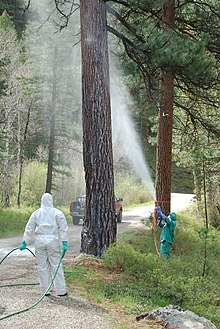Carbaryl(1-naphthyl methylcarbamate) is a chemical in thecarbamatefamily used chiefly as aninsecticide.It is a white crystalline solid previously sold under the brand nameSevin,which was a trademark of theBayerCompany.The Sevin trademark has since been acquired byGardenTech,which has eliminated carbaryl from most Sevin formulations.[needs update][3][4]Union Carbidediscovered carbaryl and introduced it commercially in 1958. Bayer purchased Aventis CropScience in 2002, a company that included Union Carbide pesticide operations. Carbaryl was the third-most-used insecticide in the United States for homegardens,commercial agriculture, and forestry and rangeland protection. As aveterinarydrug, it is known ascarbaril(INN).
| |||
| Names | |||
|---|---|---|---|
| Preferred IUPAC name
Naphthalen-1-yl methylcarbamate | |||
| Other names | |||
| Identifiers | |||
3D model (JSmol)
|
|||
| ChEBI | |||
| ChEMBL | |||
| ChemSpider | |||
| ECHA InfoCard | 100.000.505 | ||
| EC Number |
| ||
| KEGG | |||
PubChemCID
|
|||
| RTECS number |
| ||
| UNII | |||
| UN number | 2757 | ||
CompTox Dashboard(EPA)
|
|||
| |||
| |||
| Properties | |||
| C12H11NO2 | |||
| Molar mass | 201.225g·mol−1 | ||
| Appearance | Colorless crystalline solid | ||
| Density | 1.2 g/cm3 | ||
| Melting point | 142 °C (288 °F; 415 K) | ||
| Boiling point | decomposes | ||
| very low (0.01% at 20°C)[1] | |||
| Pharmacology | |||
| QP53AE01(WHO) | |||
| Hazards | |||
| GHSlabelling: | |||
   
| |||
| Danger | |||
| H301,H302,H332,H351,H410 | |||
| P201,P202,P261,P264,P270,P271,P273,P281,P301+P310,P301+P312,P304+P312,P304+P340,P308+P313,P312,P321,P330,P391,P405,P501 | |||
| Flash point | 193-202[1] | ||
| Lethal doseor concentration (LD, LC): | |||
LD50(median dose)
|
710 mg/kg (rabbit, oral) 250 mg/kg (guinea pig, oral) 850 mg/kg (rat, oral) 759 mg/kg (dog, oral) 500 mg/kg (rat, oral) 150 mg/kg (cat, oral) 128 mg/kg (mouse, oral) 230 mg/kg (rat, oral)[2] | ||
| NIOSH(US health exposure limits): | |||
PEL(Permissible)
|
TWA 5 mg/m3[1] | ||
REL(Recommended)
|
TWA 5 mg/m3[1] | ||
IDLH(Immediate danger)
|
100 mg/m3[1] | ||
| Safety data sheet(SDS) | ICSC 0121 | ||
Except where otherwise noted, data are given for materials in theirstandard state(at 25 °C [77 °F], 100 kPa).
| |||

Production
editCarbaryl is often inexpensively produced by direct reaction ofmethyl isocyanatewith1-naphthol.[5]
- C10H7OH + CH3NCO → C10H7OC(O)NHCH3
Alternatively, 1-naphthol can be treated with excessphosgeneto produce 1-naphthylchloroformate,which is then converted to carbaryl by reaction withmethylamine.[5]The former process was carried out inBhopal.In comparison, the latter synthesis uses exactly the same reagents, but in a different sequence. This procedure avoids the potential hazards of methyl isocyanate.
Biochemistry
editCarbamate insecticides are slowly irreversible inhibitors of the enzymeacetylcholinesterase.They resembleacetylcholine,but the carbamoylated enzyme undergoes the final hydrolysis step very slowly (minutes) compared with the acetylated enzyme generated by acetylcholine (microseconds). They interfere with the cholinergic nervous system and cause death because the effects of the neurotransmitter acetylcholine cannot be terminated by carbamoylated acetylcholinesterase.
Applications
editThe development of the carbamate insecticides has been called a major breakthrough inpesticides.The carbamates do not have the persistence of chlorinated pesticides. Although toxic to insects, carbaryl is detoxified and eliminated rapidly in vertebrates. It is neither concentrated in fat nor secreted in milk, so is favored for food crops, at least in the US.[6]It is the active ingredient in Carylderm shampoo used to combat head lice until infestation is eliminated.[7]
Ecology
editCarbaryl kills both targeted (e.g., malaria-carrying mosquitos) and beneficial insects (e.g.,honeybees), as well as crustaceans.[8]Because it is highly toxic tozooplankton,the algae they feed onexperience blooms.Boone & Bridges 2003 find that largeralgae eaterssuch asBufo woodhousiibenefit from this effect.[9]
Although it can increase survival rates for organisms that benefit from consequential algae blooms, the long term effects of these changes in competition levels and predation can be detrimental to many aquatic ecosystems, particularly those dominated by Anurans.[10]
It is approved for more than 100 crops in the US. Carbaryl has been illegal in the EU since 21 November 2007[11]and Angola.[12]
Safety
editCarbaryl is acholinesterase inhibitorand is toxic to humans. It is classified as a likely humancarcinogenby theUnited States Environmental Protection Agency(EPA.)[13]The oralLD50is 250 to 850 mg/kg for rats and 100 to 650 mg/kg for mice.[8]
Carbaryl can be produced usingmethyl isocyanate(MIC) as an intermediary.[5]A leak of MIC used in the production of carbaryl caused theBhopal disaster,the most lethal industrial accident in history.[14]
References
edit- ^abcdeNIOSH Pocket Guide to Chemical Hazards."#0100".National Institute for Occupational Safety and Health(NIOSH).
- ^"Carbaryl".Immediately Dangerous to Life or Health Concentrations (IDLH).National Institute for Occupational Safety and Health(NIOSH).
- ^"When Familiar Pesticides Change".
- ^"When is Sevin not Sevin?".14 February 2018.
- ^abcThomas A. Unger (1996).Pesticide Synthesis Handbook(Google Booksexcerpt).William Andrew. pp.67–68.ISBN0-8155-1401-8.
- ^Robert L. Metcalf "Insect Control" in Ullmann'sEncyclopedia of Industrial ChemistryWiley-VCH, Weinheim, 2002.doi:10.1002/14356007.a14_263
- ^Carbaryl against lice
- ^abCarbaryl General Fact Sheet - National Pesticide Information Center
- ^Kendall, Ronald; Lacher, Thomas E.; Cobb, George P.; Cox, Stephen B., eds. (2010).Wildlife Toxicology: Emerging Contaminant and Biodiversity Issues.Boca Raton:CRC.ISBN978-1-4398-1794-0.OCLC646404494.5.4.1 Taxon-Wide Impacts — Pesticides and Contaminants, and Their Roles in the Decline of Amphibian Populations. Moore, Robin D.; Claude Gascon. pp.111-145.
- ^Boone, Michelle D.; Semlitsch, Raymond D. (February 2002)."Interactions of an Insecticide With Competition and Pond Drying in Amphibian Communities".Ecological Applications.12(1):307–316.doi:10.1890/1051-0761(2002)012[0307:ioaiwc]2.0.co;2.ISSN1051-0761.
- ^"L_2007133EN.01004001.XML".
- ^Carbaryl Insecticide Hazard DataArchivedMay 11, 2010, at theWayback Machine
- ^Interim Reregistration Eligibility Decision for CarbarylArchivedJuly 25, 2008, at theWayback Machine,U.S. EPA, June 2003.
- ^Eckerman, Ingrid (2005).The Bhopal Saga—Causes and Consequences of the World's Largest Industrial Disaster.India: Universities Press.doi:10.13140/2.1.3457.5364.ISBN81-7371-515-7.
External links
edit- Carbaryl Technical Fact Sheet - National Pesticide Information Center
- Carbaryl Pesticide Information Profile - Extension Toxicology Network
- Cholinesterase Inhibition - Extension Toxicology Network
- EPA info
- EPA factsheet
- IPCS (WHO) Health and Safety Guide
- Environmental Health Criteria - WHO
- Exclusive Chemistry Ltd - routes of Sevin synthesis
- CDC - NIOSH Pocket Guide to Chemical Hazards
- Carbarylin the Pesticide Properties DataBase (PPDB)

